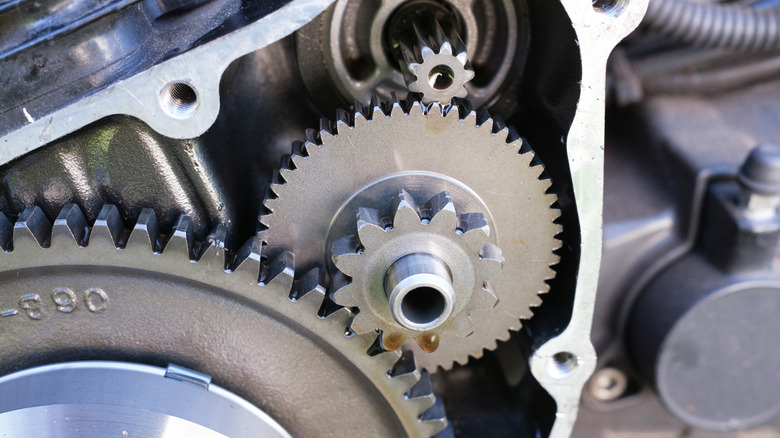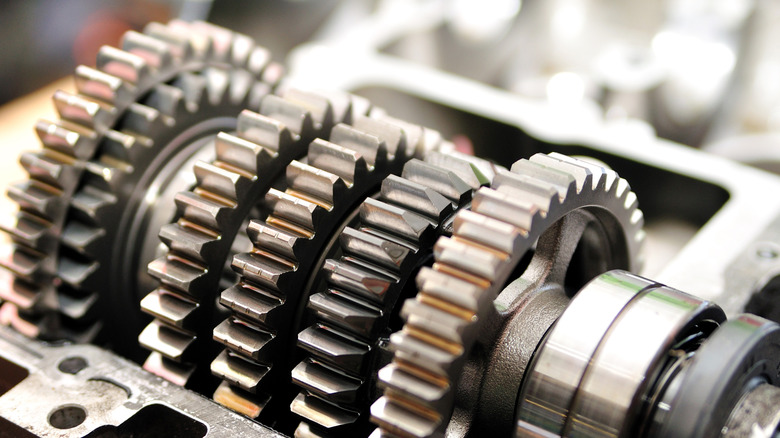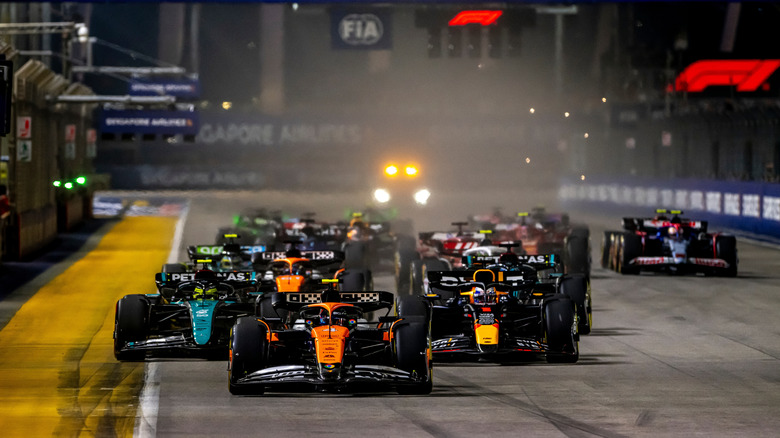What Is A Sequential Transmission And How Does It Work?
Typically (but not always) found in specialized cars and motorcycles, a sequential manual transmission, often shortened to just "sequential," is a type of manual gearbox which, like a traditional manual, requires its user to shift gears themselves. However, it uses dog clutches rather than a traditional synchromesh associated with a normal manual, and has all the gears rotating at the same time. As a result, the function of the clutch pedal between shifting is all operated mechanically by the transmission. This produces far faster shift times in comparison to a regular manual because the operator simply actuates a paddle-shifter or a lever to change gears without the need to depress the clutch pedal. This produces some truly blistering shift speeds, with even modern F1 cars utilizing sequential transmissions.
Outside of motorsport, these transmissions most often show up on roads in motorcycles. The shifter is typically controlled by a rider's left foot, or down on the lever so that a rider doesn't have to remove their hands from the handlebars to shift, like on a "suicide clutch" and hand-shifter found on some antique motorcycles. These transmissions are notably different from many others which feature paddle-shift mechanisms, such as semi-automatic or DCT setups. Outside of motorcycles, the vehicles most often equipped with sequential manuals are race cars, such as the latest NASCAR cup car generation. Because of their idiosyncrasies and their more niche nature, sequential transmissions seldom find their way into road cars (even less-so than traditional manual transmissions in road cars today), with such vehicles generally being sports cars or limited-production hypercars like the Pagani Huayra and E60-series BMW M5. Let's explore the anatomy of these gearboxes and their typical usage in cars and motorcycles.
Breaking down the sequential manual transmission
Much like almost all modern transmissions, sequential manuals consist of a labyrinth of gears, shafts, and linkages. But when you understand the basic mechanics, it's deceptively simple.
Imagine you have two shafts, and each contains its own gears. Now, the top shaft links into the engine and the bottom to the driveshaft. Let's say the top shaft has a larger gear and the bottom a smaller gear. That means, mechanically speaking, that the top shaft will rotate faster than the bottom when that gear is engaged. That's your first gear – the selection with the largest gear on top and smallest on bottom. As you go through the gears, the top gear will get smaller and smaller, and the bottom will get larger. This changes the ratio, so now the bottom shaft is spinning more quickly in relation to the top, meaning the wheels are spinning more quickly for the same engine RPM. These are the vehicle's higher gears.
As for how shifting is done, let's say you have a 6-speed plus reverse, so seven gears. Next, pretend you have seven "hands" on the top shaft, each with their own gear. When you shift into first, the first gear's "hand" will grab onto that first gear. This means that now both shafts are rotating at first-gear speed. When you shift to second, the "hand" then releases its grip on first, and instead the second-gear "hand" grips onto its gear. This process is done mechanically through a ratchet, which tells the system which hands to grip and release, with only one hand gripping at a time. The hands are known as dog clutches, and are why sequential transmissions don't require a regular clutch to operate beyond the launch.
Common usages of sequential manual transmissions
As previously mentioned, the two most well-known applications are motorsports and motorcycles, with more niche applications in specific high-performance road cars. The history of sequential manuals in race cars is deceptively nuanced, with multiple instances of the technology falling to obscurity. It began following World War II, with one of the first Grand Prix prototype cars developed by Porsche, the Type 360 Cisitalia, featuring the first sequential manual fitted to a race car. However, this early prototype never hit the circuit in anger; that honor belonged to Lotus' "Queerbox" (so-called because of its unusual design) of late-1950s Formula 2.
Ferrari became the first to properly field a sequential F1 car, contesting the 1989 season with the Ferrari 640. Its frankly ludicrously fast shift times in comparison to a manual demonstrated the overwhelming advantage of such a design, despite its initial unreliability and complexity. By 1995, no Formula 1 car fielded an H-pattern gearbox anymore, with every team opting for sequentials. The sequential gearbox continues to dominate large aspects of most racing-focused motorsports, such as Formula 1, NASCAR, touring cars, V8 Supercars, GT racing, and so on.
In terms of road usage, motorcycles utilized manual transmissions since 1911, and while numerous alternative transmission formats including automatics, DCTs, and CVTs have found usage since the 1960s, the sequential manual continues its reign in the two-wheeled world. It's easily operated, safer than hand-operated shifters, and it's generally even faster at shifting than a dual-clutch transmission. In addition, its small size means that there's not as much material dragging on the system like a full-size car with a sequential. However, sufficiently high-performance road cars may seldom feature a sequential manual as well, utilizing its numerous advantages while brute-forcing the parasitic drag of having all the gears linked together at the same time.


